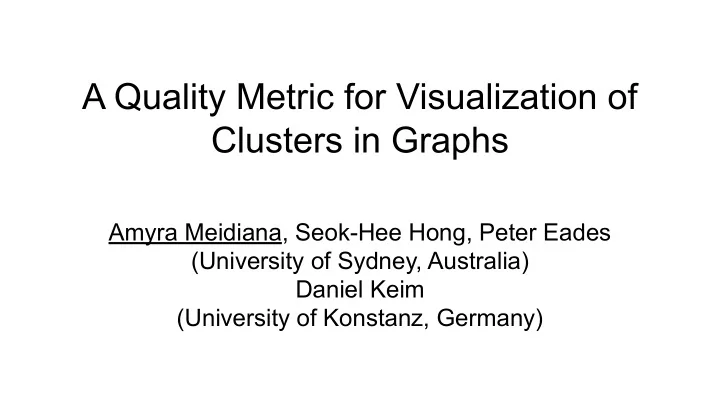

A Quality Metric for Visualization of Clusters in Graphs Amyra Meidiana, Seok-Hee Hong, Peter Eades (University of Sydney, Australia) Daniel Keim (University of Konstanz, Germany)
Motivation ● Clustering is an important task in graph analysis ● No metric exists that measures how faithfully a graph drawing displays the clustering structure of the graph ● Aim: define, implement and evaluate a quality metric quantifying how faithfully a graph drawing displays a graph’s clustering structure
Contribution 1. Design and implement a new clustering quality metric 2. Experiment 1: Validate the clustering quality metric through graph drawing deformation experiments 3. Experiment 2: Compare various graph drawing algorithms using the clustering quality metric
Clustering Quality Metric: Framework
Clustering Quality Metric: Details ● Geometric clustering C’: k-means clustering ● Clustering comparison metrics: Adjusted Rand Index (ARI): measures clustering similarity based on # of item pairs ○ classified into the same cluster in both clusterings & into different clusters in both clusterings Adjusted Mutual Information (AMI): measures how much information of one ○ clustering can be gained from the other Fowlkes-Mallows Index (FMI): measures the similarity of C’ to C using the number ○ of true positives, false positives, and false negatives Completeness (CMP): the extent to which all members of a cluster in C are ○ assigned to the same cluster in C’ Homogeneity (HOM): the extent to which each cluster in C′ only contains members ○ of the same cluster in C
Experiment 1: Validation Experiment ● Validation experiment steps: Start with a good graph drawing with no cluster overlap 1. Perturb vertex positions to deform the cluster structures in the drawing 2. ● Validation experiments performed on synthetic graphs with known ground truth clusters ● Hypothesis 1: Clustering quality metric scores will decrease as the drawings are further deformed
Validation Experiments Examples Step 0 Step 3 Step 7 Step 10
Validation Experiments Examples Step 0 Step 3 Step 7 Step 10
Validation Experiments Results ● Scores decrease as the drawings are distorted, validating Hypothesis 1 ● CQ ARI and CQ FMI are more sensitive in capturing changes in quality
Experiment 2: Layout Comparison ● Layout comparison using clustering quality metrics ● Cluster-focused layouts: LinLog, Backbone, tsNET ● Other layouts: Force-directed layouts (Fruchterman Reingold (FR), Organic) ○ Multilevel force-directed layouts (FM3, sfdp) ○ MDS-based layouts (Metric MDS, Pivot MDS) ○ Stress-based layouts (Stress Majorization, Sparse Stress Minimization) ○ Spectral layout ○ ● Hypothesis 2: the cluster-focused layouts will score higher on clustering quality metrics than other layouts
Layout Comparison Example: Synthetic dataset FR Organic Stress Maj. Metric MDS Backbone FM3 Spectral S. Stress Min. tsNET Pivot MDS sfdp LinLog
Layout Comparison Examples: real world dataset FR Organic Stress Maj. Metric MDS Backbone FM3 Spectral S. Stress Min. tsNET Pivot MDS sfdp LinLog Data taken from: Leskovec, J., Krevl, A.: SNAP Datasets: Stanford large network dataset collection. http://snap.stanford.edu/data (Jun 2014)
Layout Comparison Results ● LinLog and tsNET attain the top two scores averaged over all datasets, supporting Hypothesis 2 ● Backbone is in the top three for real world datasets ● sfdp scores highest among non-cluster focused layouts ● Organic and MDS layouts fall on the low end of CQ scores Average over all comparison datasets Average over real world datasets
Summary ● Designed, implemented, and validated a clustering quality metric for graph drawings ● Evaluated various graph layout algorithms using the metrics and validated the claims of some cluster-focused layout Future work ● Combination with readability metrics (e.g. to address node overlap issues) ● Use other geometric clustering methods ● Extension to data clustering metrics
Recommend
More recommend